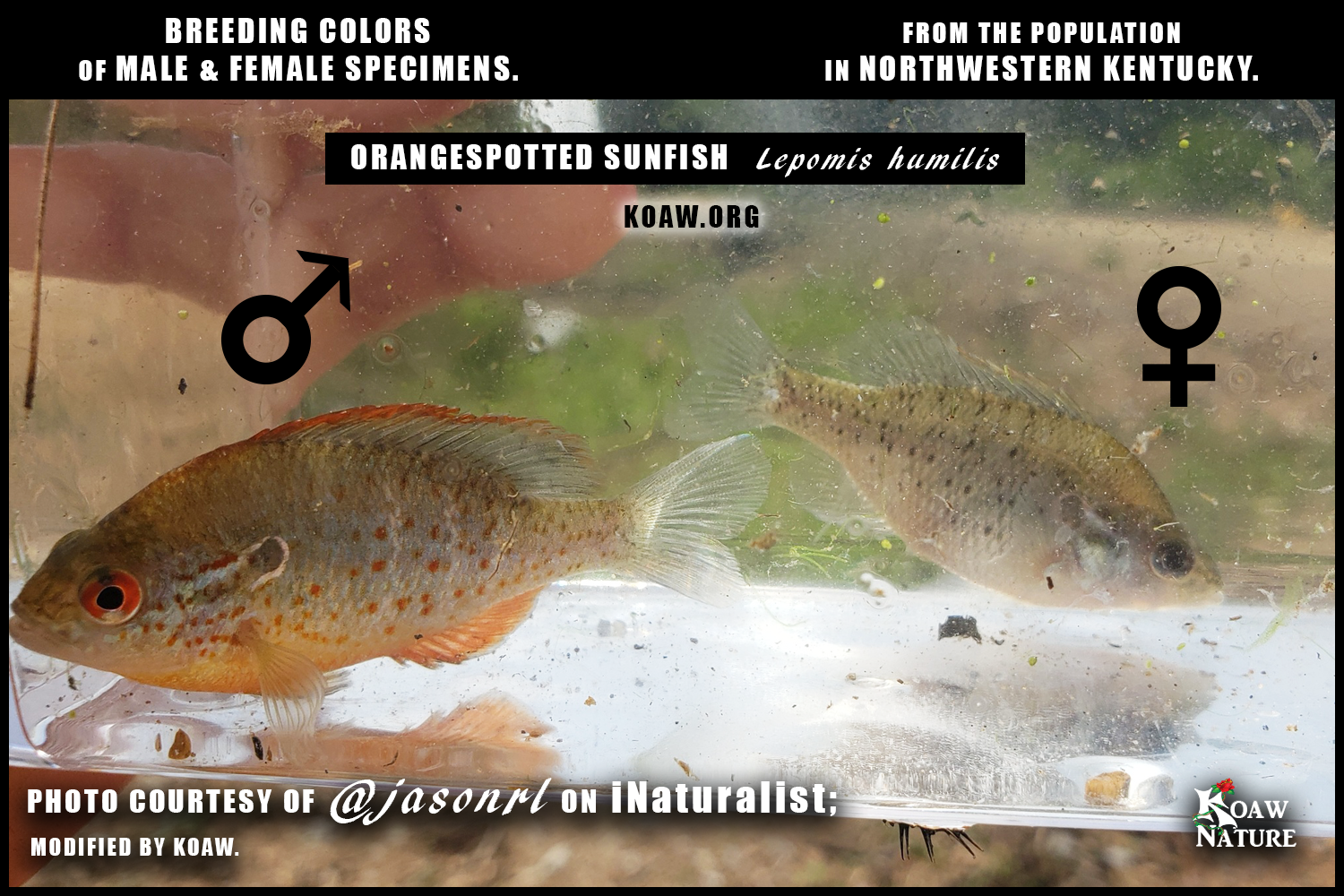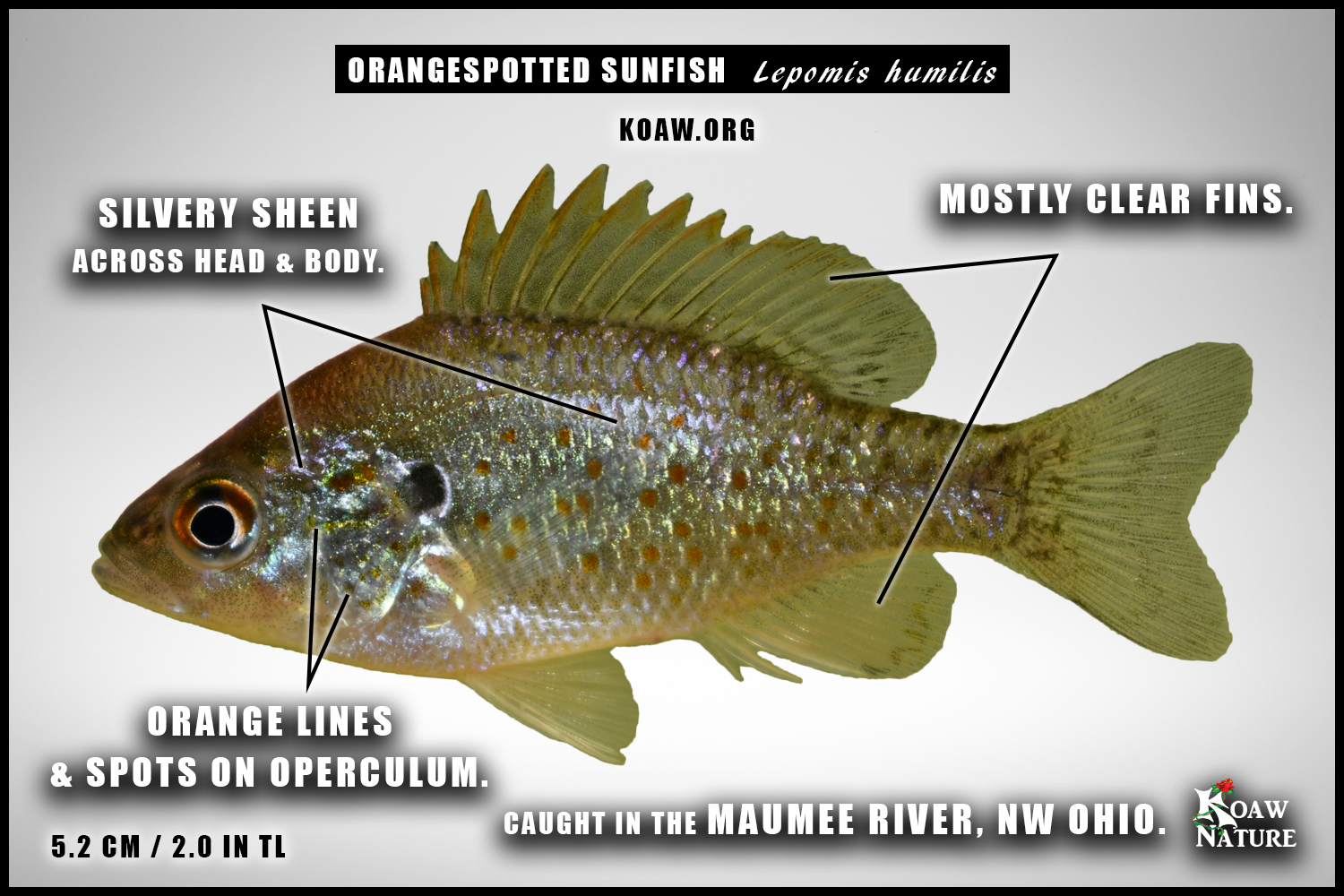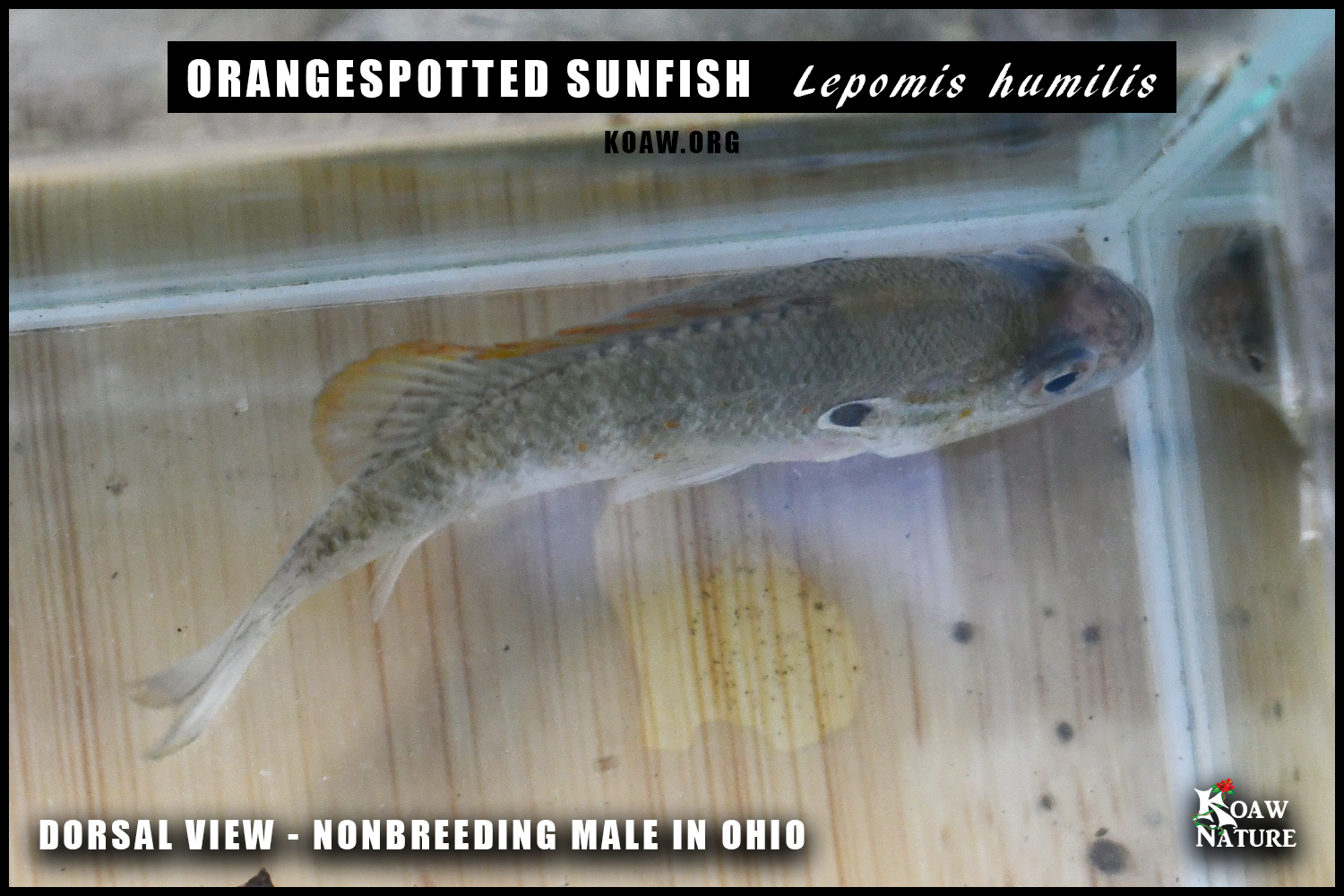By Koaw - October, 2020 (Updated 2022)
GENERAL: The orangespotted sunfish (Lepomis humilis - Girard, 1858) is not a commonly encountered specimen simply because this species is rarely sought by fishers due to its small size. The fish also remains inconspicuous under cover within creeks and rivers, often in turbid waters.
Good features to examine for identification are the all-white edging around the opercular flap, the elongated body, the silvery sheen along the body and the orange/red/brown spots and wavy bands on the body and gill plate, respectively.
BODY: The orangespotted sunfish has a deep, compressed body that is more elongated than most other lepomids, that is, the lateral view appears more fusiform like a football rather than roundly (though some populations do have deeper, more roundly bodies.) The lateral line is complete, normally with 32-41 lateral scales. [1]
Click to enlarge.
COLORATION: The orangespotted sunfish has an overall silvery sheen along the body with iridescent silvery blue flecks. Conspicuous orange spots are present along the body where, especially on breeding specimens, the spots may be bright orange or sometimes reddish (on males) or appear red or entirely brown (on females). Young will have bars that may also appear as clusters of touching spots.
Breeding males will have very vibrant colors where the head and body takes on a more pronounced blue hue and the median fins express more reddish orange. The breast and belly will also take on more color, typically a reddish orange though sometimes a pale yellow.
Wavy orange lines (often just composed of spots) are typical along the gill cover, sometimes visible along the cheek. The fins are primarily clear (except on breeding males) with minimal mottling.
These two specimens I caught in Ohio show distinct breeding colors. The males are just gorgeous while the females are much more drab.
SIZE: To 15 cm (6 in). [1] The orangespotted sunfish is one of the smaller species within the genus Lepomis.
OPERCULAR FLAP: The opercular flap or “ear flap” will be edged with white edging. The flap is small, typically no larger than the eye. Hubbs and Lagler (2004) suggest that breeding males may have some slight orange edging around the opercular flap, [2] of which, I am yet to observe on any specimen in the field or on observation photos where introgression/hybridization with other lepomids was not suspected.
This is a great feature to use when comparing to other congeneric species inhabiting the same waters. Bluegill (Lepomis macrochirus) will have no colored edging around the opercular flap while the other species that have colored edging will usually have distinct orange, purple or red somewhere in the posterior edge of the opercular flap.
The longear sunfish (Lepomis megalotis) does tend to have a mostly pale-edged opercular flap similar to that of the orangespotted sunfish though the longear’s opercular flap should be larger in size for similar-sized specimens.
GILL RAKERS: The gill rakers along the 1st gill arch are long and thin. These are seen by lifting the gill cover and looking at the white portion above the red filaments on the gill arch closest to the gill cover.
Note that this is a small species and if the specimen under examination is less than 9 cm (3.5 in) then it will be much trickier to get a lift on that gill cover.
I made a video describing how to locate and find these rakers that is hosted on Koaw Nature’s Fishing Smarts YouTube channel.
MOUTH SIZE: The mouth of the orangespotted sunfish is fairly large. The upper jaw usually extends to or past the eye’s pupil; more specifically, the posterior edge of the maxilla will reach or pass the anterior edge of the eye’s pupil.
Also note that this species most often has an elongated snout relative to the other lepomids. However, a broader snout may exist in some populations; this phenotypic plasticity is most likely a result of available diet during development, where if larger prey is readily available a broader snout develops as well as deeper body. [3]
PECTORAL FIN: The pectoral fin is rounded and moderately-sized within most populations. If bent forward, the pectoral fin usually aligns with the anterior portion of the eye or the anterior portion of the pupil.
Typically there are 14 pectoral rays. [1]
HABITAT: Orangespotted sunfish are most often found in creeks and rivers, especially doing well in turbid or silty waters. [1] It is suggested that the increasing turbidity of many waterways is allowing the orangespotted populations to spread. [2] Common in and around scattered cover such as fallen branches.
CLICK TO ENLARGE - This distribution map is an illustrated approximation created by Koaw primarily pulling data and information from USGS-NAS, Research Grade observations from iNaturalist and Page & Burr’s Field Guide to Freshwater Fishes.
LOCATION: Lepomis humilis is almost entirely confined to the United States with some introduced populations in the northern parts of Mexico and possibly some populations extending into areas of Ontario, Canada adjacent to Detroit. [4]
The orangespotted sunfish has been documented in the Missouri River Basin and Souris-Red-Rainy Basin starting in North Dakota. The range extends southerly, including the Upper & Lower Mississippi River Basins, the Arkansas-White-Red Basin and Texas Gulf Coast Basin, though no populations reported in the Ozark Plateau.
Indigenous populations also exist in the Ohio River Basin, Tennessee River basin & South Atlantic Gulf Basin, wherein the latter, populations have spread much more easterly. The Great Lakes Basin has seen introduced populations in Indiana, Ohio & Michigan. Southeast Texas has introduced populations. [1] [5] [4]
FISHING: Want to catch some orangespotted? Unless you plan on using a net then it’s time to break out the smaller gear! Even though the mouth is fairly large, most specimens will be not much longer than your index finger. I’d recommend getting out the size 12-14 hooks (or smaller) for flies and live bait.
Cut worms on a hook do very well capturing this species. I had success also using bead-head flies where I added cut plastic tails to give it the wiggle and a bigger profile. It might require some patience; I found the aggressiveness-to-bait behavior of this species to be fairly low compared to the other sunfishes.
If you’re not looking for record-size orangespotted then I recommend just throwing on a size 18 hook with a cut bit of worm; you’ll still get plenty of adult specimens.
SIMILAR SPECIES: While fishing for this project in Ohio, I was catching young crappie and orangespotted sunfish in the same waters. I realized that there was a close resemblance that might be tricky to differentiate to an untrained-eye. When in doubt, always count the spines! The black crappie is used in the comparison image. White crappie will have 5-6 dorsal spines, 6-7 anal spines and a slightly smaller dorsal fin base length.
REFERENCES:
L. M. Page and B. M. Burr, Peterson Field Guide to Freshwater Fishes, Houghton Mifflin Harcourt Publishing Company, 2011.
C. L. Hubbs and K. F. Lagler, FISHES of the Great Lakes Region: Revised Edition/ Revised by Gerald R. Smith, The University of Michigan Press, 2004.
S. Hegrenes, "Diet-induced phenotypic plasticity of feeding morphology in the orangespotted sunfish, Lepomis humilis," Ecology of Freshwater Fish, vol. 10, pp. 35-42, 2001.
USGS, "USGS - Nonnative Aquatic Species - Lepomis humilis Orangespotted Sunfish," [Online]. Available: https://nas.er.usgs.gov/queries/SpeciesAnimatedMap.aspx?SpeciesID=383. [Accessed September 2020].
iNaturalist, "iNaturalist Orangespotted Sunfish Lepomis humilis," [Online]. Available: https://www.inaturalist.org/taxa/104253-Lepomis-humilis. [Accessed Sept. 2020].



